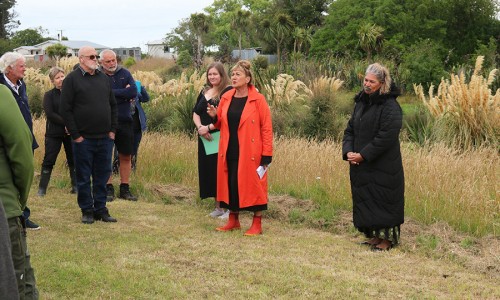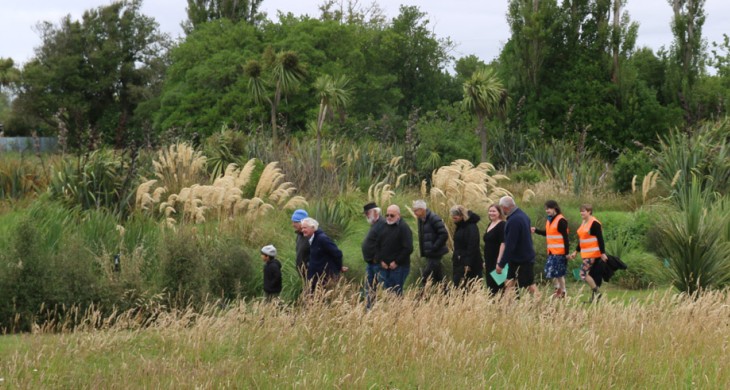10 February 2025
The Whakaora Te Waikēkēwai constructed wetland project, Te Repo o Papatahora, celebrates a key milestone as ground is broken this month.
Te Taumutu Rūnanga invited whānau, Whakaora Te Waikēkēwai partners and neighbouring landowners to gather for a karakia whakawātea event at the site of Te Repo o Papatahora, observing the beginning of construction on the long-awaited wetland restoration project adjacent to Te Pā o Moki.
The karakia whakawātea, a spiritual clearing of the land to prepare for works, acknowledged not only the breaking of ground, but also a weaving together of cultural, ecological, and historical aspirations to restore Te Waikēkēwai/Waikēkēwai Stream for generations to come.
The construction phase of this project is estimated to conclude March 2025, and will be followed by native riparian and littoral (wetland) planting.
Find out more about Whakaora Te Waikēkēwai and Te Repo o Papatahora.
A vision for Te Waikēkēwai
Te Repo o Papatahora is a cornerstone of the Whakaora Te Waikēkēwai project, a five-year initiative led by Te Taumutu Rūnanga, with support from Environment Canterbury Regional Council and the Ministry for the Environment’s Freshwater Improvement Fund, to improve water quality, restore mahinga kai values and enhance biodiversity along Te Waikēkēwai/Waikēkēwai Stream.
The wetland’s design, a collaborative effort between the project team, rūnanga and two major consultants; Morphum Environmental — for wetland design and hydrology — and Mahaanui Kurataio (MKT) — for Mātauranga Māori monitoring — balances innovations in environmental science with Mātauranga Māori. Once complete, the wetland will act as a vital habitat for indigenous species, increase water quality and serve as a living symbol of cultural revitalisation and ecological sustainability.
Te Waikēkēwai/Waikēkēwai Stream signifies an important whakapapa/genealogical connection for the rūnanga, flowing through ancestral sites tied to revered tīpuna/ancestors Te Ruahikihiki and his son Moki, whose legacies continue to shape the identity and aspirations of Ngāi Te Ruahikihiki hapū.
The area once provided abundant food-gathering resources, but over generations, the land use changed and opportunities to gather mahinga kai were all but lost.
After many years spent restoring the lower reaches of the awa/stream between the marae and Te Waihora/Lake Ellesmere, the rūnanga began to shift their focus upstream — reaching out to neighbouring landowners whose properties will also benefit from the wetland.
It was important to Te Taumutu whānau to ensure their own backyard was tidy, before asking others to do the same.
Reflecting on the journey to Te Repo o Papatahora
Following the karakia whakawātea, Liz Brown, Ngāi Tahu Co-Governor and Co-Chair of the Te Waihora Co-Governance group, spoke with manuhiri, reflecting on the five-year ecological restoration work programme.
"The Whakaora Te Waikēkēwai project is a significant one for Taumutu Rūnanga and Ngāi Te Ruahikihiki. Not only has the project allowed us to build on our long-held vision to restore Te Waihora to the majestic lake it once was, but it has also become an important part of our journey to have our voice heard and for us to be part of the decision making once again for Te Waihora."
"Working collectively with our project partners, we have welcomed the opportunity for co-design and co-management."
We know that together we can achieve something environmentally and culturally significant — something that will benefit us, the wider community and the future generations who come here."

Liz Brown reflected on the five-year restoration work
Restoring the mauri of Waikēkēwai through partnership
Whakaora Te Waikēkēwai project manager, Sophie McGregor, is looking forward to watching the wetland take shape.
"It's incredibly exciting to be at this stage where we are finally breaking ground at Te Repo o Papatahora. This milestone brings us one step closer to our long-term vision of a landscape that's rich in mahinga kai and cultural values."
"Not only will the wetland provide more opportunities for Te Taumutu Rūnanga and whānau in the mahinga kai space, but it will also improve water quality and biodiversity in the area, which means a healthier Te Waihora catchment."
Restoration mahi ahead
Beginning February 2025, project works include reshaping (rebattering) portions of Papatahora Stream upstream from the marae, sediment removal from the length of Papatahora Stream and installation of two sediment traps to aid in sediment control.
Sections along Papatahora Stream will see native trees planted following construction, complementing the already extensive restoration efforts completed by the neighbouring landowner. This revegetation will not only help to improve water quality within Papatahora Stream, but also what flows down into Te Waikēkēwai/Waikēkēwai Stream and subsequently into Te Waihora/Lake Ellesmere.
Both the construction work and riparian planting aims to improve indigenous biodiversity, expand access for mahinga kai, help Papatahora Stream to work with the wetland in managing water flows and enable whānau to closely connect with te taiao/the natural world.
Te Repo o Papatahora will initially be an isolated wetland, however, the programme intends to explore additional opportunities to connect into the wider landscape. This includes investigating a diversion of Papatahora Stream through the wetland to further increase mahinga kai values, fish passage management work, and other projects focused on increasing habitat for native plant and animal life.

